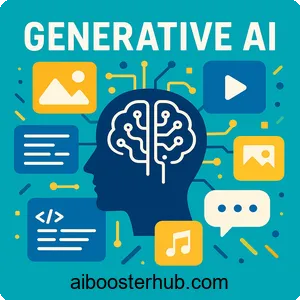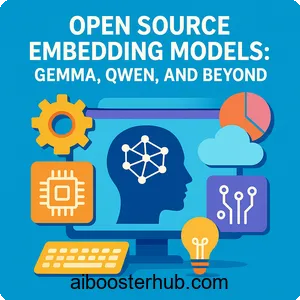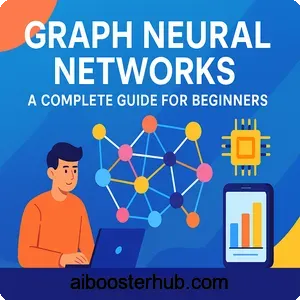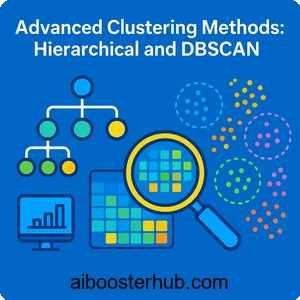Generative AI: Understanding Modern Artificial Intelligence
The landscape of artificial intelligence has undergone a remarkable transformation with the emergence of generative AI, a technology that has captured the imagination of researchers, businesses, and the general public alike. Unlike traditional AI systems that primarily focus on analyzing and classifying existing data, generative artificial intelligence possesses the extraordinary capability to create entirely new content, from realistic images and coherent text to complex code and original music. This shift marks a paradigm change in how we use AI in daily life, beyond just improving capabilities.

Content
Toggle1. What is generative AI?
Generative AI represents a category of artificial intelligence systems designed to create new content based on patterns learned from training data. Unlike discriminative models that classify or predict based on input data, generative models learn the underlying distribution of data and can produce novel instances that maintain the statistical properties of the original dataset. This fundamental capability distinguishes generative artificial intelligence from other AI approaches and enables a wide range of creative and practical applications.
The term “generative” refers to the model’s ability to generate new samples, while “generic AI” is sometimes mistakenly used when referring to these systems. However, it’s important to understand that generative AI is anything but generic—it’s highly specialized in understanding and replicating complex data patterns. These systems utilize sophisticated neural networks and deep learning architectures to capture intricate relationships within data, enabling them to produce outputs that are both novel and contextually appropriate.
The fundamental principles
Generative models operate on the principle of learning a probability distribution \( P(X) \) over a dataset, where \( X \) represents the data samples. Once this distribution is learned, the model can sample from it to generate new instances. Mathematically, a generative model aims to maximize the likelihood of the training data:
$$\max_{\theta} \prod_{i=1}^{N} P(x_i | \theta)$$
where \( \theta \) represents the model parameters, and \( x_i \) are individual training samples. This optimization process ensures that the generated samples closely resemble the training distribution while maintaining diversity and novelty. The beauty of this approach lies in its ability to capture not just surface-level features but deep, underlying structures in the data.
Key characteristics of generative systems
Several defining characteristics set generative AI apart from other artificial intelligence approaches. First, these systems demonstrate creativity in the traditional sense—they can produce outputs that have never existed before while maintaining coherence and relevance. Second, they exhibit contextual understanding, generating content that appropriately responds to prompts or conditions. Third, they possess scalability, capable of generating unlimited variations from learned patterns. Finally, they show adaptability, with the ability to be fine-tuned for specific domains or styles without complete retraining.
Consider a simple example using Python to understand the basic concept of generation. While this is a simplified illustration, it demonstrates the core principle:
import numpy as np
import matplotlib.pyplot as plt
# Simple generative model: Learning a distribution
training_data = np.random.normal(loc=50, scale=10, size=1000)
# Model learns mean and std from data
learned_mean = np.mean(training_data)
learned_std = np.std(training_data)
# Generate new samples from learned distribution
generated_samples = np.random.normal(loc=learned_mean, scale=learned_std, size=1000)
print(f"Original mean: 50, Learned mean: {learned_mean:.2f}")
print(f"Original std: 10, Learned std: {learned_std:.2f}")2. Core architectures in generative AI
The remarkable capabilities of generative artificial intelligence stem from sophisticated neural network architectures that have evolved through years of research in deep learning. These architectures represent different approaches to the challenge of learning and generating complex data distributions, each with unique strengths and applications. Understanding these core architectures is essential for grasping how modern generative AI systems achieve their impressive results.
Generative Adversarial Networks (GANs)
Generative Adversarial Networks revolutionized the field of generative AI by introducing a game-theoretic approach to generation. A GAN consists of two neural networks: a generator \( G \) that creates samples, and a discriminator \( D \) that attempts to distinguish real samples from generated ones. These networks engage in a competitive process where the generator improves by trying to fool the discriminator, while the discriminator gets better at detecting fakes.
The training objective for GANs can be expressed as a minimax game:
$$\min_{G} \max_{D} \mathbb{E}_{x \sim p_{data}}[\log D(x)] + \mathbb{E}_{z \sim p_z}[\log(1 – D(G(z)))]$$
where \( x \) represents real data samples, \( z \) is random noise input to the generator, and \( D(x) \) represents the discriminator’s probability estimate that \( x \) is real. This adversarial training process pushes both networks to improve continuously, resulting in a generator capable of producing highly realistic samples. GANs have been particularly successful in image generation, creating photorealistic faces, artwork, and even video content.
Here’s a simplified implementation structure of a GAN in Python:
import torch
import torch.nn as nn
class Generator(nn.Module):
def __init__(self, input_dim, output_dim):
super(Generator, self).__init__()
self.model = nn.Sequential(
nn.Linear(input_dim, 256),
nn.ReLU(),
nn.Linear(256, 512),
nn.ReLU(),
nn.Linear(512, output_dim),
nn.Tanh()
)
def forward(self, z):
return self.model(z)
class Discriminator(nn.Module):
def __init__(self, input_dim):
super(Discriminator, self).__init__()
self.model = nn.Sequential(
nn.Linear(input_dim, 512),
nn.LeakyReLU(0.2),
nn.Linear(512, 256),
nn.LeakyReLU(0.2),
nn.Linear(256, 1),
nn.Sigmoid()
)
def forward(self, x):
return self.model(x)
# Initialize models
latent_dim = 100
data_dim = 784 # e.g., 28x28 images flattened
generator = Generator(latent_dim, data_dim)
discriminator = Discriminator(data_dim)Variational Autoencoders (VAEs)
Variational Autoencoders take a different approach to generative modeling by learning a compressed latent representation of the data. A VAE consists of an encoder that maps input data to a latent space and a decoder that reconstructs data from latent representations. Unlike standard autoencoders, VAEs learn a continuous latent space with specific statistical properties, enabling smooth interpolation and controlled generation.
The VAE objective combines reconstruction loss with a regularization term that encourages the latent space to follow a known distribution, typically a standard normal distribution:
$$\mathcal{L} = \mathbb{E}_{q(z|x)}[\log p(x|z)] – D_{KL}(q(z|x) \parallel p(z))$$
where \( q(z|x) \) is the approximate posterior distribution encoded by the encoder, \( p(x|z) \) is the decoder’s reconstruction probability, and \( D_{KL} \) represents the Kullback-Leibler divergence. This formulation ensures that the latent space is well-structured and continuous, making VAEs particularly useful for applications requiring controlled generation and interpolation between samples.
Diffusion models
Diffusion models represent one of the most recent and powerful approaches to generative AI. These models work by gradually adding noise to data through a forward diffusion process, then learning to reverse this process to generate new samples from pure noise. The reverse process is learned through a neural network that predicts the noise to be removed at each step.
The forward diffusion process can be described as:
$$q(x_t | x_{t-1}) = \mathcal{N}(x_t; \sqrt{1-\beta_t} x_{t-1}, \beta_t I)$$
where \( \beta_t \) controls the amount of noise added at each timestep \( t \). The reverse process, which the model learns, generates samples by iteratively denoising:
$$p_\theta(x_{t-1} | x_t) = \mathcal{N}(x_{t-1}; \mu_\theta(x_t, t), \Sigma_\theta(x_t, t))$$
Diffusion models have achieved state-of-the-art results in image generation, producing highly detailed and diverse outputs. Their iterative refinement process allows for excellent control over the generation process and tends to be more stable than GANs during training.
Transformer-based generative models
Transformers have revolutionized natural language processing and have been adapted for various generative tasks. These architectures use self-attention mechanisms to capture long-range dependencies in sequential data. Large language models like GPT use transformer architectures to generate coherent, contextually appropriate text by predicting the next token in a sequence.
The self-attention mechanism computes attention weights as:
$$\text{Attention}(Q, K, V) = \text{softmax}\left(\frac{QK^T}{\sqrt{d_k}}\right)V$$
where \( Q \), \( K \), and \( V \) represent query, key, and value matrices, and \( d_k \) is the dimension of the key vectors. This mechanism allows the model to focus on relevant parts of the input when generating each output token, enabling sophisticated understanding and generation of complex sequences.
3. How generative AI learns and generates
Understanding the learning process of generative artificial intelligence provides crucial insights into both its capabilities and limitations. The journey from raw training data to a model capable of producing novel, high-quality outputs involves sophisticated optimization techniques, massive computational resources, and careful architectural design. This learning process distinguishes generation AI from simpler machine learning approaches and enables its remarkable creative abilities.
The training process
Training a generative model begins with data collection and preparation. Large datasets containing examples of the desired output type—whether images, text, audio, or other modalities—are assembled and preprocessed. For instance, a generative model for creating artwork might be trained on millions of images, while a language model would be trained on vast text corpora spanning books, websites, and diverse written content.
During training, the model iteratively adjusts its parameters to better capture the patterns in the training data. This process typically involves computing a loss function that measures how well the model’s outputs match the desired behavior, then using gradient descent to update the model parameters. For a basic neural network component, this update rule follows:
$$\theta_{t+1} = \theta_t – \eta \nabla_\theta \mathcal{L}(\theta_t)$$
where \( \theta \) represents the model parameters, \( \eta \) is the learning rate, and \( \nabla_\theta \mathcal{L} \) is the gradient of the loss function. Modern generative models often employ sophisticated optimizers like Adam that adapt the learning rate for each parameter based on historical gradients.
Representation learning and latent spaces
A critical aspect of generative AI is its ability to learn meaningful representations of data in lower-dimensional latent spaces. These latent representations capture the essential features and structures of the data in a compressed form. For example, a generative model trained on face images might learn latent dimensions corresponding to features like age, gender, facial expression, and lighting conditions, even though these categories were never explicitly labeled during training.
The quality of the latent space significantly impacts generation capabilities. A well-structured latent space exhibits smoothness, meaning that small changes in the latent representation produce small, meaningful changes in the generated output. This property enables interpolation between different samples and controlled manipulation of generated content. Consider this Python example demonstrating latent space interpolation:
import numpy as np
def interpolate_latent_space(z1, z2, num_steps=10):
"""
Interpolate between two latent vectors
Args:
z1: First latent vector
z2: Second latent vector
num_steps: Number of interpolation steps
Returns:
List of interpolated latent vectors
"""
interpolated = []
for alpha in np.linspace(0, 1, num_steps):
# Linear interpolation
z_interp = (1 - alpha) * z1 + alpha * z2
interpolated.append(z_interp)
return interpolated
# Example usage
z_start = np.random.randn(100) # Random latent vector
z_end = np.random.randn(100) # Another random latent vector
interpolated_vectors = interpolate_latent_space(z_start, z_end)
print(f"Generated {len(interpolated_vectors)} interpolated latent vectors")Sampling and generation strategies
Once trained, generative models employ various sampling strategies to produce new outputs. The choice of sampling method significantly affects the quality, diversity, and controllability of generated content. In language models, for instance, sampling strategies include greedy decoding (always selecting the most probable next token), beam search (maintaining multiple candidate sequences), and temperature-controlled sampling (adjusting the randomness of selections).
Temperature sampling modifies the probability distribution over possible outputs according to:
$$P(x_i) = \frac{\exp(z_i / T)}{\sum_j \exp(z_j / T)}$$
where \( z_i \) represents the logit for option \( i \), and \( T \) is the temperature parameter. Lower temperatures (\( T < 1 \)) make the model more confident and deterministic, while higher temperatures (\( T > 1 \)) increase randomness and diversity in outputs. This simple parameter provides powerful control over the generation process.
Conditioning and controlled generation
Modern generative AI systems often incorporate conditioning mechanisms that allow users to guide the generation process. Conditional generation modifies the model to produce outputs based on specific inputs or constraints. This capability has enabled practical applications like text-to-image generation, where natural language descriptions guide image creation, or style transfer, where generated content adopts particular aesthetic characteristics.
Conditional probability in generative models can be expressed as \( P(X|C) \), where \( X \) represents the generated output and \( C \) represents the conditioning information. The model learns to generate samples that are both realistic (matching the training data distribution) and consistent with the provided conditions. This dual objective requires careful architecture design and training procedures to ensure the model responds appropriately to conditioning signals while maintaining output quality.
4. Applications and use cases of generative AI
The practical applications of generative artificial intelligence span an incredibly diverse range of domains, transforming industries and enabling entirely new possibilities. From creative endeavors to scientific research, from business automation to entertainment, generative AI has demonstrated its versatility and power. Understanding these applications provides context for the technology’s impact and hints at its future potential.
Creative content generation
One of the most visible applications of generative AI lies in creative content production. Text generation models can write articles, stories, poetry, and marketing copy with remarkable fluency and creativity. Image generation systems create original artwork, design logos, generate photorealistic images, and even produce animations. Music generation models compose original scores, while video generation systems are beginning to create short video clips from text descriptions.
These creative applications don’t simply replace human creativity but rather augment it, providing tools that help artists and creators explore new ideas quickly, overcome creative blocks, and produce variations on concepts. A graphic designer might use generative AI to rapidly prototype dozens of logo variations, then refine the most promising ones. A writer might use language models to brainstorm plot ideas or develop character backgrounds. The technology serves as a collaborative tool that amplifies human creativity rather than replacing it.
Code generation and software development
Generative AI has made significant inroads into software development through code generation capabilities. Models trained on vast repositories of code can generate functions, complete code snippets, write tests, and even explain existing code. These tools accelerate development workflows, help developers learn new programming languages, and reduce the time spent on boilerplate code.
Consider a practical example where a developer might request a function to process data:
# Example: Generative AI can produce code like this from descriptions
def analyze_customer_data(data, metric='revenue'):
"""
Analyze customer data and return key statistics
Args:
data: List of dictionaries containing customer information
metric: The metric to analyze ('revenue', 'purchases', etc.)
Returns:
Dictionary with statistical analysis
"""
values = [customer.get(metric, 0) for customer in data]
analysis = {
'total': sum(values),
'average': sum(values) / len(values) if values else 0,
'maximum': max(values) if values else 0,
'minimum': min(values) if values else 0,
'count': len(values)
}
return analysis
# Example usage
customers = [
{'name': 'Alice', 'revenue': 1500, 'purchases': 5},
{'name': 'Bob', 'revenue': 2300, 'purchases': 8},
{'name': 'Charlie', 'revenue': 1100, 'purchases': 3}
]
results = analyze_customer_data(customers, metric='revenue')
print(f"Total revenue: ${results['total']}")Scientific research and drug discovery
In scientific domains, generative AI accelerates research by generating hypotheses, designing experiments, and discovering novel compounds. In drug discovery, generative models can design new molecular structures with desired properties, potentially reducing the time and cost of developing new medications. These models learn the relationships between molecular structures and their properties, then generate candidates that might have therapeutic value.
The process involves generating molecular structures that satisfy multiple constraints simultaneously—they must be chemically valid, synthetically accessible, likely to bind to specific target proteins, and possess favorable safety profiles. This multi-objective optimization problem is naturally suited to generative AI approaches, which can explore vast chemical spaces far more efficiently than traditional methods.
Personalization and recommendation systems
Generative AI enhances personalization by creating customized content for individual users. Rather than simply recommending existing items, generative systems can create personalized emails, product descriptions, user interfaces, and even entire experiences tailored to individual preferences and contexts. This capability enables a new level of personalization in marketing, education, and user experience design.
Educational platforms use generative AI to create customized learning materials adapted to each student’s level, learning style, and pace. Marketing systems generate personalized product descriptions and recommendations that resonate with individual customers. These applications leverage the model’s ability to understand context and generate appropriate, relevant content on demand.
Data augmentation and synthetic data generation
Training robust machine learning models often requires large, diverse datasets that may be difficult or expensive to collect. Generative AI addresses this challenge by creating synthetic training data that augments real datasets. This approach is particularly valuable in domains where data is scarce, sensitive, or expensive to collect, such as medical imaging, rare event detection, or privacy-sensitive applications.
Synthetic data generation must balance realism with diversity. The generated samples should be realistic enough to be useful for training, but diverse enough to cover edge cases and variations that might not be well-represented in the original data. Careful validation ensures that models trained on synthetic data generalize well to real-world scenarios.
5. Challenges and limitations
Despite the impressive capabilities of generative artificial intelligence, the technology faces significant challenges and limitations that must be understood and addressed. These challenges span technical, ethical, and practical dimensions, and acknowledging them is crucial for responsible development and deployment of generative AI systems.
Quality and consistency concerns
While generative AI can produce remarkable outputs, ensuring consistent quality remains challenging. Models sometimes generate content with subtle errors, inconsistencies, or artifacts that can be difficult to detect automatically. Language models might produce plausible-sounding but factually incorrect statements, a phenomenon known as “hallucination.” Image generators might create anatomically impossible structures or physically inconsistent scenes.
These quality issues stem from the probabilistic nature of generative models. The models learn statistical patterns from training data but don’t truly understand the content they generate. They lack the semantic understanding and common sense reasoning that humans apply naturally. Addressing these limitations requires combining generative models with verification systems, human review processes, and complementary AI approaches that can detect and correct errors.
Computational resources and environmental impact
Training large generative models requires enormous computational resources. State-of-the-art models may require thousands of GPUs running for weeks or months, consuming massive amounts of electricity. This computational intensity has environmental implications, as the energy consumption contributes to carbon emissions. The cost also creates barriers to entry, concentrating the ability to develop advanced generative AI in well-funded organizations.
Researchers are actively working on more efficient training methods, model compression techniques, and architectural innovations that reduce computational requirements. Techniques like knowledge distillation, pruning, and quantization can reduce model size and inference costs while maintaining performance. However, the fundamental trade-off between model capability and computational cost remains a significant challenge.
Bias and fairness
Generative models learn from training data that inevitably contains biases reflecting historical and societal inequalities. These biases can be amplified and perpetuated in generated content, leading to unfair or discriminatory outputs. For example, image generation models might associate certain professions predominantly with particular genders or ethnicities, reflecting biases in their training data.
Addressing bias in generative AI requires multifaceted approaches. Data curation and augmentation can help balance training datasets. Architectural modifications and training objectives can be designed to reduce bias. Post-processing filters can detect and mitigate problematic outputs. However, completely eliminating bias remains an open challenge, requiring ongoing research and careful monitoring of deployed systems.
Ethical considerations and misuse potential
The ability to generate realistic content raises serious ethical concerns. Generative AI can create deepfakes, generate misleading information, impersonate individuals, or create content that violates copyright or intellectual property rights. The technology can be weaponized for disinformation campaigns, fraud, or harassment. These risks necessitate careful consideration of how generative AI is developed, deployed, and regulated.
Responsible development of generative AI includes implementing safeguards, developing detection methods for generated content, establishing clear usage policies, and fostering public awareness of the technology’s capabilities and limitations. Technical solutions like watermarking generated content, implementing usage restrictions, and developing robust detection methods complement policy and educational approaches to mitigating misuse risks.
Intellectual property and attribution
Generative AI’s relationship with intellectual property raises complex legal and ethical questions. When a model trained on copyrighted works generates new content, who owns that content? How should original creators whose work contributed to training data be credited or compensated? These questions lack clear answers and are subject to ongoing legal and policy debates.
Different jurisdictions are developing varied approaches to these questions, creating uncertainty for developers and users of generative AI systems. Clear frameworks for attribution, compensation, and rights management are needed to ensure fair treatment of original creators while enabling beneficial applications of generative AI technology.
6. The future of generative AI
The trajectory of generative artificial intelligence points toward increasingly capable, efficient, and accessible systems that will continue transforming how we create, work, and interact with technology. Understanding emerging trends and future directions helps stakeholders prepare for the opportunities and challenges ahead.
Multimodal generation
Future generative AI systems will increasingly work across multiple modalities simultaneously, understanding and generating combinations of text, images, audio, and video in unified frameworks. Rather than separate models for each modality, integrated systems will enable richer, more coherent generation that combines different content types seamlessly. Imagine describing a scene in text and having a system generate not just an image but a short video with appropriate audio, all coherently representing the described scenario.
These multimodal capabilities will enable new applications in entertainment, education, and communication. Virtual environments could be generated from natural language descriptions. Educational content could automatically adapt its presentation format based on the topic and learner preferences. Communication tools could translate not just words but entire contexts across languages and cultures.
Improved efficiency and accessibility
Ongoing research focuses on developing more efficient generative models that require less computational power and data. Techniques like few-shot learning enable models to adapt to new tasks with minimal examples. Model compression and optimization make powerful generative capabilities accessible on consumer devices rather than requiring cloud infrastructure. These advances will democratize access to generative AI, enabling broader participation in its development and use.
Efficiency improvements also address environmental concerns by reducing the energy consumption of training and inference. As methods become more efficient, the barrier to entry for researchers and developers decreases, potentially leading to more diverse innovation in the field.
Enhanced control and reliability
Future developments will provide users with finer-grained control over generation processes while improving output reliability. Advanced conditioning mechanisms will allow precise specification of desired properties. Verification systems will catch errors and inconsistencies before they reach users. These improvements will make generative AI more suitable for critical applications where reliability is paramount.
Combining generative models with reasoning systems and knowledge bases will reduce hallucinations and improve factual accuracy. Interpretability research will make it easier to understand why models generate particular outputs, enabling better debugging and refinement. These advances will bridge the gap between the impressive but sometimes unreliable capabilities of current systems and the robust performance required for widespread deployment.
Integration into everyday tools
Generative AI will become increasingly integrated into the tools and applications people use daily. Rather than standalone systems, generative capabilities will be embedded in word processors, design software, development environments, and communication platforms. This integration will make advanced AI capabilities accessible to users without requiring specialized knowledge, broadening the technology’s impact.
As integration deepens, the distinction between “using AI” and “using software” may blur. Generative capabilities will become expected features of modern tools, much like spell-checking and auto-complete are today. This normalization will shift focus from the technology itself to the creative and productive outcomes it enables.
Collaborative human-AI systems
The future of generative AI likely involves increasing collaboration between human creativity and AI capabilities. Rather than AI replacing human creators, we’ll see the emergence of collaborative workflows where humans and AI systems complement each other’s strengths. Humans provide high-level direction, creativity, and judgment, while AI handles execution, generates variations, and accelerates iteration.
These collaborative approaches will require new interface designs, interaction paradigms, and workflows that facilitate smooth human-AI collaboration. Understanding how to effectively collaborate with AI systems will become an important skill across many professions. Education and training programs will need to adapt to prepare people for this collaborative future.
8. Conclusion
Generative AI fundamentally transforms how we conceive and interact with artificial intelligence systems today. Moving beyond analysis to creation, it opens new possibilities across virtually every human domain. Technical foundations in neural networks enable practical applications in art, science, and business effectively. The technology demonstrates remarkable capabilities alongside important limitations requiring responsible understanding and action.
Success depends on technical advances and thoughtful consideration of ethical implications moving forward. Appropriate governance frameworks and collaborative approaches must leverage both human and artificial intelligence. Understanding generative AI’s mechanisms, applications, and challenges equips us to navigate this transformation wisely. We can harness its benefits while mitigating risks through informed decision-making and engagement. Our current actions will shape the future, making thoughtful participation more crucial than ever.









